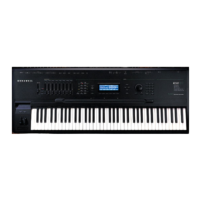Keymap and Sample Editing
Editing Samples
14-13
thezeropointofthedisplay(thehorizontallineinthemiddleofthewaveformdisplay.)Though
adjustingthesepointsvisuallyishelpful,alwayslistentothesampleandmakethefinalsettings
basedonwhatsoundsbest.You’llnoticeanaudibleclickinyoursampleloopiftheendsof
the
waveformdonotmeetwheretheloopoccurs.Thecloseryoucan getthetwoendsofthe
waveform,thebetterthe soundqualityofyourloopwillbe.Usingzero‐crossingsfortheLoop
andEndparametersmayalsohelpreduceclicksatthelooppoint,seeZero‐
andZero+belowfor
details.
TheEnd(E)parametersetsthepointatwhichthecurrentsamplewillstopplayback.Typically
you’llusethisparametertotrimunwantedsilenceofftheendofasample,althoughyoucanuse
ittoshortenasampleasmuchasyouwant.
NoteOnSaving
Samples:Trimmedportionsofasamplearenotsaved.Trimmedportionsbeforethe
Start(S),orAlternativeSt art(A)points(whicheverhasalower value)willbelostuponsaving,and
whicheverparameterhadalowervaluewillhaveavalueofzerothenexttimeitisloaded(values
forall
othersamplepointparameterswillbeadjustedrelatively.)TrimmedportionsaftertheAlternativeStart
(A)orEnd(E)points(whicheverhasahighervalue)willbelostuponsaving.Ifyouwishtosaveacopyof
theoriginaluntrimmedsample,savethetrimmedversionunderadifferent
ID#(thiswillnotuse
additionalsamplememory.)IfyousaveatrimmedfactoryROMsampleatitsoriginalID#,youcan
alwaysrestoretheoriginalversionbydeletingthemodifiedversionthatyousaved.Todeleteasample,see
OBJECT on page 11‐12,theDeletefunction.
Zoom- and Zoom+
Thesebuttonsincreaseordecreasethe
resolutionofthewaveformdisplay,enablingyoutoseea
largerorsmallerseg m entofthe waveformofthecurrentlyselectedsample.Thetoplineofthe
displayindicatesthezoompositionintermsofafraction—forexample,1/256—whichindicates
thenumberofindividualsampleelementsrepresentedbyeachdisplay
pixel.Avalueof1/256
meansthateachpixelrepresents256individualsampleelements.Themaximumzoomsetting
of1showsyouaverysmallsegmentofthesample.Theminimumsettingof1/16384showsyou
thelargestpossiblesegmentofthesample.EachpressofaZoomsoftbuttonincreases
or
decreasesthezoombyafactorof4.
Gain- and Gain+
Thesebuttonsincreaseordecreasethemagnificationofthecurrentlydisplayedsample
waveform,enablingyoutoseethewaveformingreaterorlesserdetail.Attheleftofthedisplay,
you’llseethemagnificationsetting,whichisexpressedindBunits.
Youcanadjustthe
magnificationfrom48dB(maximummagnification)to 0 dB.Thisdoesn’taffecttheactual
amplitudeofthesample,onlythemagnificationofitsdisplay.
ThesimplestwaytothinkoftheZoomandGainbuttonsistorememberthattheZoombuttons
controltheleft/rightmagnificationofthewaveform,
whiletheGainbuttonscontroltheup/
downmagnification.Neitherbuttonhasanyaffectonthesoundofthesample.You’lloftenuse
theZoomandGainsoftbuttonstogethertofocusinonaparticularsamplesegment,then
magnifyittoseeitinclosedetail.
Forexample,youmightwant
tozoomouttoviewanentiresamplewaveform,todecidewhich
segmentyouwanttoedit.Youcouldthenzoomintofocusonaparticularsegment.Onceyou’ve
zoomedin,youmaywanttoboosttheGaintoenableyoutosetanewStart(S)pointwith
greaterprecision,orensurethatyougetasmoothlooptransition.
Zero- and Zero+
PressingtheZero‐orZero+buttonswillsearchleftorrightrespectivelyforthesample’snext
zero‐crossing.Azero‐crossingisapointwherethesamplewaveformisneitherpositiveor
negative(crossingthehorizontallineinthemiddle
ofthewaveformdisplay.)Thecurrently
selectedparameter(Start(S),AlternativeStart(A),Loop(L),orEnd(E))willbesettothispoint
inthesample.S ettingtheseparameterstozero‐crossingscanhelpminimizeclicksatthestart,
end,orlooppointofasample.It’sbestto
haveeachofthesepointssetfirstbyadjustingeach
parameterandlisteningtothesample,thenifneededsearchforanearbyzero‐crossing.

